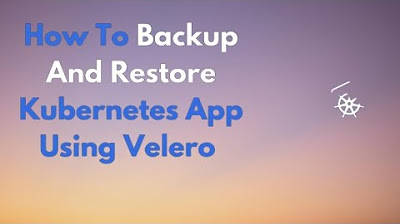Backups - CompTIA Security+ SY0-701 - 3.4
Summary
TLDRThis video script emphasizes the critical importance of data backup strategies, covering various types such as on-site, off-site, and cloud backups. It discusses backup media, scheduling, and the necessity of testing backups for restoration. The script also explores advanced options like snapshots for virtual machines, real-time replication for disaster recovery, and journaling to prevent data corruption during power outages, advocating for a comprehensive approach to data protection.
Takeaways
- 🛡️ Always maintain a backup to recover from data loss efficiently.
- 🔍 Consider various factors in the backup process, including data size, backup type, and media.
- 📍 Choose between on-site and off-site backups based on accessibility and cost.
- 🗃️ Decide where to store backup media post-backup, considering on-site, off-site, or cloud options.
- 🤖 Use appropriate software for both backup and restoration, which may be third-party or built-in.
- ⏰ Establish a backup schedule that aligns with data change frequency and system usage.
- 🏢 Understand the difference between on-site and off-site backups for immediate availability and long-term storage.
- 🔒 Implement security measures, especially for sensitive data in backups, including encryption.
- 📅 Plan backup intervals based on data volume and system activity to optimize storage and recovery.
- 📈 Utilize snapshots for virtual machines as an easy and efficient backup method, capturing system states over time.
- 🔄 Test backups regularly to ensure data can be restored properly in case of a disaster.
Q & A
Why is it important to have a backup?
-Having a backup is crucial as it allows for the recovery of data in case of loss, often with relative ease and speed.
What are the different variables to consider when planning a backup?
-Variables to consider include the amount of data to back up, the type of backup, the media used for backup, the storage location of the backup media, the software for backup and restoration, and the backup schedule.
What are the main types of backup media mentioned in the script?
-The main types of backup media mentioned are local tape or hard drive, and cloud storage.
What are the advantages of on-site backups?
-On-site backups are advantageous because the data and backup media are located at the same place, making the data immediately available and generally less expensive than off-site storage.
How does an off-site backup differ from an on-site backup?
-An off-site backup involves transferring data to a different location for storage, which can be useful for disaster recovery and long-term storage, but may involve additional costs.
What is the purpose of storing backup media in different intervals?
-Storing backup media in different intervals allows for various recovery points, depending on the frequency of data changes and the importance of the data.
Why is it necessary to test backups?
-Testing backups is necessary to ensure that the data can be properly restored in the event of a disaster or data loss, verifying that all backup methods are working correctly.
What is a snapshot and how is it used in backups?
-A snapshot is a backup method for virtual machines and cloud infrastructures that allows for an entire system to be backed up with a single action, creating a copy that can be used for rollback or recovery.
How does encryption play a role in securing backup data?
-Encryption ensures that backup data is unreadable by unauthorized third parties, protecting sensitive or private information, especially when backups are stored off-site or in the cloud.
What is replication and how does it differ from traditional backups?
-Replication is a process that copies data to one or many locations simultaneously, updating all copies in near real time whenever the original data changes, providing a real-time backup solution.
What is journaling and how does it help prevent data corruption during power outages?
-Journaling is a method where data is first written to a journal before being written to the database. If power is lost during the process, the database remains uncorrupted, and the journal can be used to recover the missing data upon system restart.
Outlines

هذا القسم متوفر فقط للمشتركين. يرجى الترقية للوصول إلى هذه الميزة.
قم بالترقية الآنMindmap

هذا القسم متوفر فقط للمشتركين. يرجى الترقية للوصول إلى هذه الميزة.
قم بالترقية الآنKeywords

هذا القسم متوفر فقط للمشتركين. يرجى الترقية للوصول إلى هذه الميزة.
قم بالترقية الآنHighlights

هذا القسم متوفر فقط للمشتركين. يرجى الترقية للوصول إلى هذه الميزة.
قم بالترقية الآنTranscripts

هذا القسم متوفر فقط للمشتركين. يرجى الترقية للوصول إلى هذه الميزة.
قم بالترقية الآنتصفح المزيد من مقاطع الفيديو ذات الصلة

CompTIA Security+ SY0-701 Course - 3.4 Importance of Resilience & Recovery in Security Architecture

Como NÃO PERDER SEUS ARQUIVOS!! // descubra como fazer um BACKUP SEGURO e FÁCIL!

3-2-1 Backup Strategy - Make Your Data Untouchable

Processing Topologies|Introduction to IoT|On-Site|Off-Site|Remote& Collaborative processing|Critical

DevOps Tutorials | Kubernetes cluster backup and restore with Velero - Kubernetes cluster backup

Cara Mengamankan Website dari Serangan Hacker | IDCloudHost
5.0 / 5 (0 votes)
